This post is also available in: Español
This easy recipe for pupusas is a great way to bring the flavor of this delicious dish from El Salvador home. I have included easy step-by-step instructions for making pupas as well as tips for making the best dough and choose the best fillings.
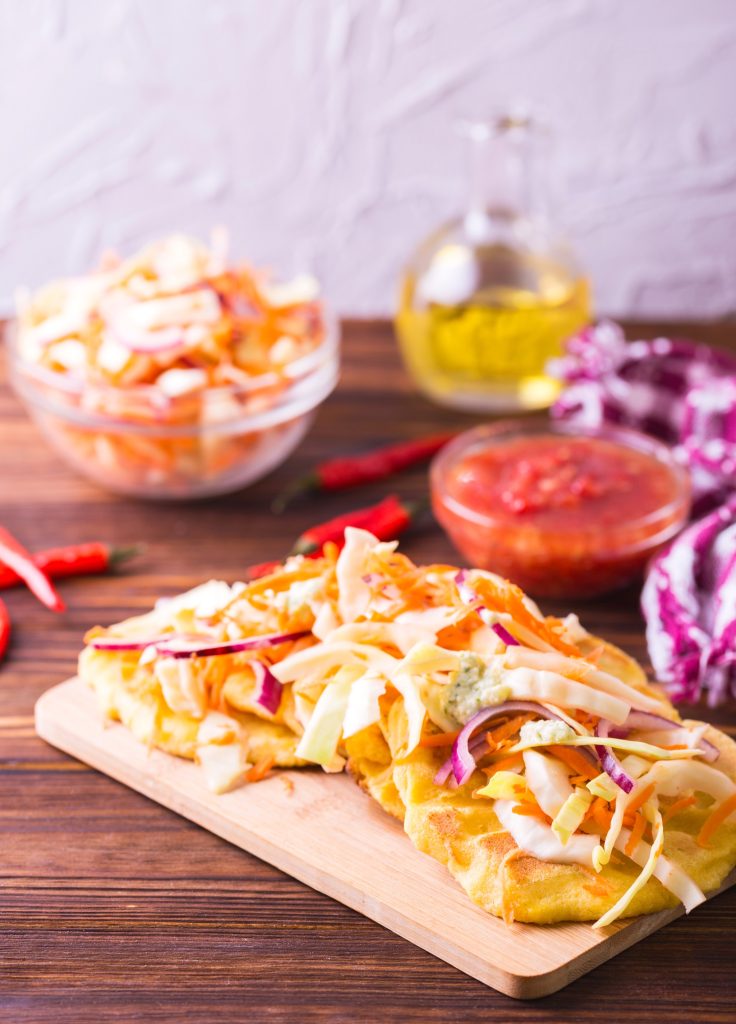
As a Guatemalan I used to think pupusas were from Guatemala, and that is why I thought it would be great to share my favorite Guatemalan pupusas recipe. However I now know that. Pupusas are a very popular food not only in El Salvador, where they’ve been declared the National dish but it is a popular food in other Central American countries from Guatemala to Honduras and Nicaragua. I grew up in Guatemala City eating pupusas, which are considered a popular Guatemalan food. I loved going to the pupuseria near my house to get freshly made pupusas. Now that I live in Florida, it is not that easy to find a pupuseria, but I can still enjoy pupusas every time I have a craving for them by making them at home.
What are Pupusas?
Pupusas are a traditional dish from El Salvador, enjoyed throughout Central America. They are thick tortillas made from corn dough and filled with various ingredients such as cheese, beans, chayote or meats like pork (chicharron) and chicken. Pupusas are then grilled until they are slightly crispy on the outside yet soft and delicious on the inside. People usually eat pupusas with their hands, often folding them, and they always come with tomato sauce and curtido, a kind of spicy coleslaw.
Pupusas are one of the most popular street foods not only in El Salvador, where they originated but in many other Central American countries that have adopted them as a favorite food perfect for sharing with family and friends. One of the great things about pupusas is their versatility and their portability; they are perfect for taking with you on a picnic or as a quick lunch at work. And with this easy recipe for pupusas you can make pupusas at home in no time!
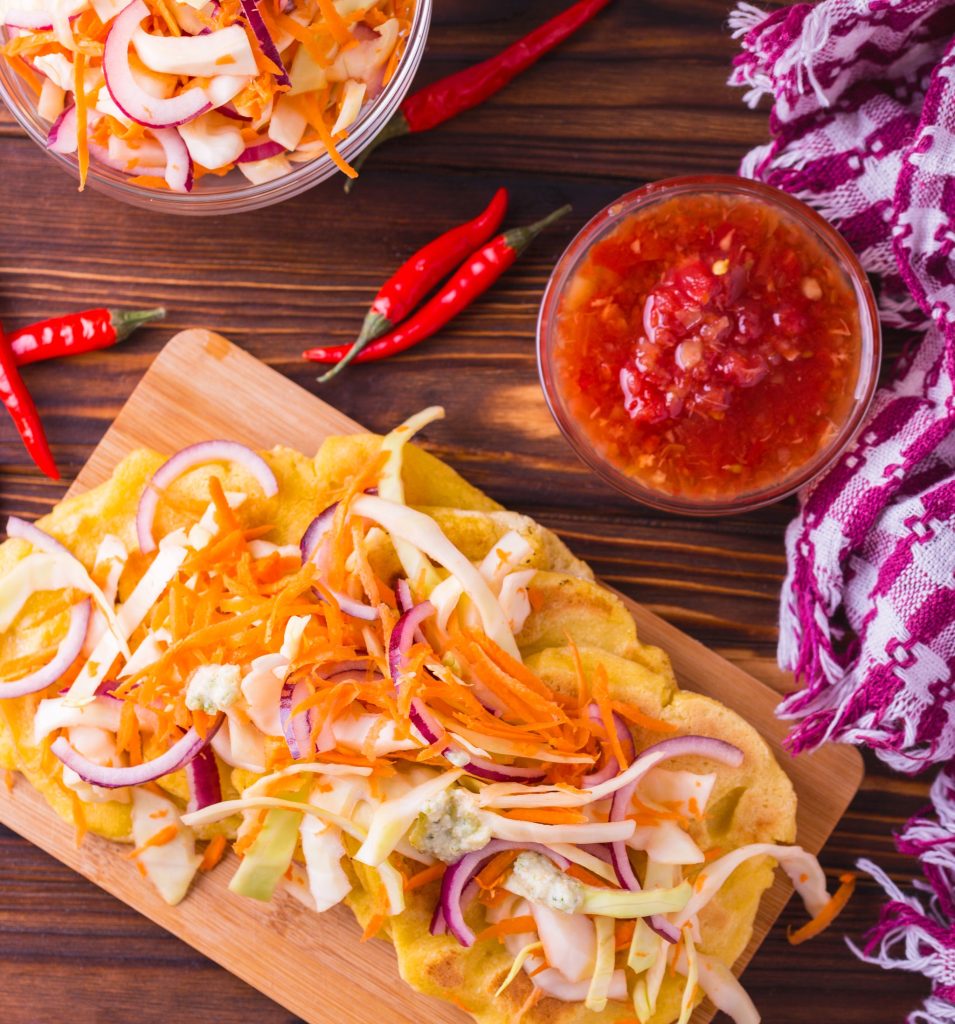
History and Origin of Popusas
The origin of the pupusa, a popular dish in El Salvador, isn’t entirely clear, but it’s believed to have pre-Hispanic roots based on descriptions of native Mesoamerican foods. While some historians believe that a similar dish to the pupusas dates back to the indigenous Pipil tribes of El Salvador other scholars who’ve studied this recently think the pupusa may originally come from the Maya Quiché or K’iche’ people.
Salvadoran anthropologist Ramón Rivas suggests that early versions of pupusas were mentioned in a 16th-century text, indicating they were a mix of local and Spanish culinary practices. However, ingredients like chicken, cheese, and cooking methods such as frying, were introduced later by the Spanish, showing the evolution of the pupusa over time. Historians and anthropologists debate whether the descriptions might refer to similar foods like tamales, but agree that the pupusa’s history reflects a blend of cultures and changes over time, making it a key part of Central American cuisine.
What are the Ingredients for Pupusas?
The main ingredients for making pupusas are simple, yet the combination creates a truly delicious and unique dish. The main ingredient of the popusas is masa harina, a type of corn flour, mixed with water to form the dough, although there are rice flour versions of the pupusa thought they are not the most popular.
The fillings can vary, including quesillo, a soft melty cheese, and refried beans. They can also be filled with vegetables like lorocos or chayote or mixed with cheese and meats like chicharrón (a flavorful pork preparation) or chicken. You ca also combine two or more of these ingredients to make popusas revueltas.
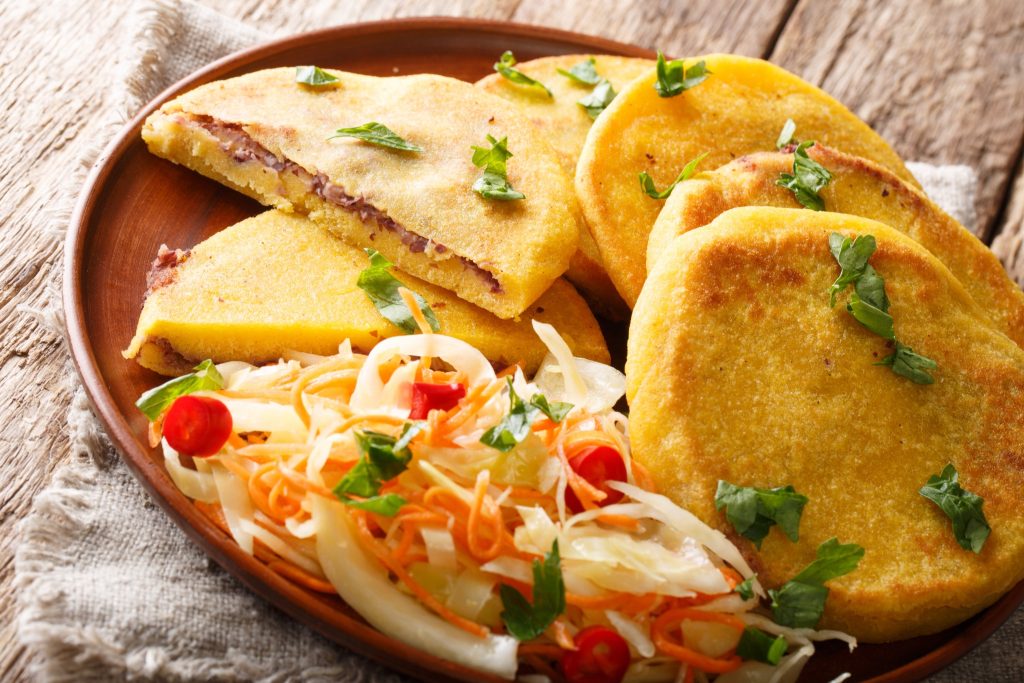
The pupusa is eaten with the hands, sometimes folded, and always accompanied by tomato sauce and curtido (a type of pickled cabbage slaw).
How do you make popusas?
This easy recipe for pupusas is an exciting way to explore a traditional Central American dish. To start, you’ll need two main components: the dough and the filling. The dough is made from a special corn flour, mixed with water to create a soft and pliable texture. For the filling, you can choose from a variety of ingredients like cheese, beans, or shredded pork, each offering its own unique flavor.
The process begins by shaping the dough into small balls, then flattening each one into a disk. This is where your creativity comes into play. You’ll place a spoonful of your chosen filling onto the center of each disk, then carefully fold and seal the dough around the filling. The goal is to enclose the filling completely within the dough, then flatten it out slightly to form the pupusa.
Next comes cooking. A skillet or griddle over medium heat is all you need. Place your pupusas on the heated surface and let them cook until they’re golden brown on each side, revealing a deliciously crispy exterior with a warm, gooey center.
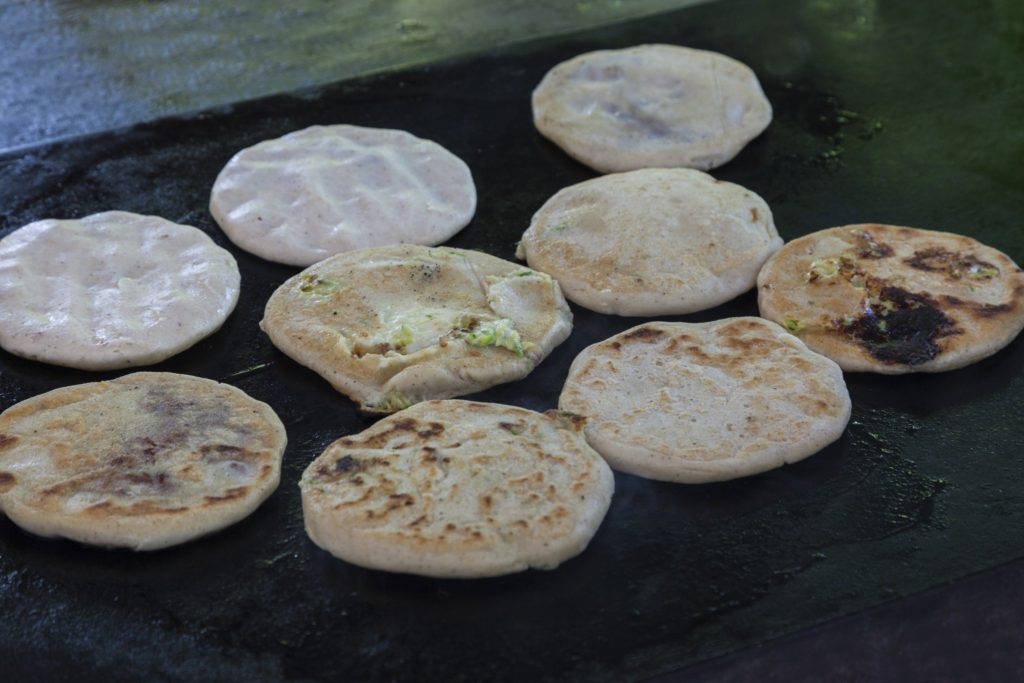
Serving pupusas is just as important as making them. They are typically enjoyed with a side of curtido, a tangy cabbage slaw, and tomato salsa, adding layers of flavor and texture to each bite. While making pupusas might seem simple, the true art lies in the balance of ingredients and the care taken in sealing and cooking them to perfection. It’s a wonderful way to bring a taste of Central America into your kitchen, creating a meal that’s not just food, but a cultural experience.
Pupuasas: Regional Variations
Pupusas may have the same basic idea everywhere, but they do vary from region to region. In El Salvador, you might find pupusas filled with loroco, a local flower, or a mix of beans, cheese, and pork called pupusas revueltas. In contrast, Guatemalan pupusas might be a bit different, often thinner and filled with a wider variety of ingredients, including local vegetables like chipilin or different types of cheese. This regional twist on the basic easy recipe for pupusas shows how food can adapt to the tastes and ingredients of a place, making each pupusa unique.
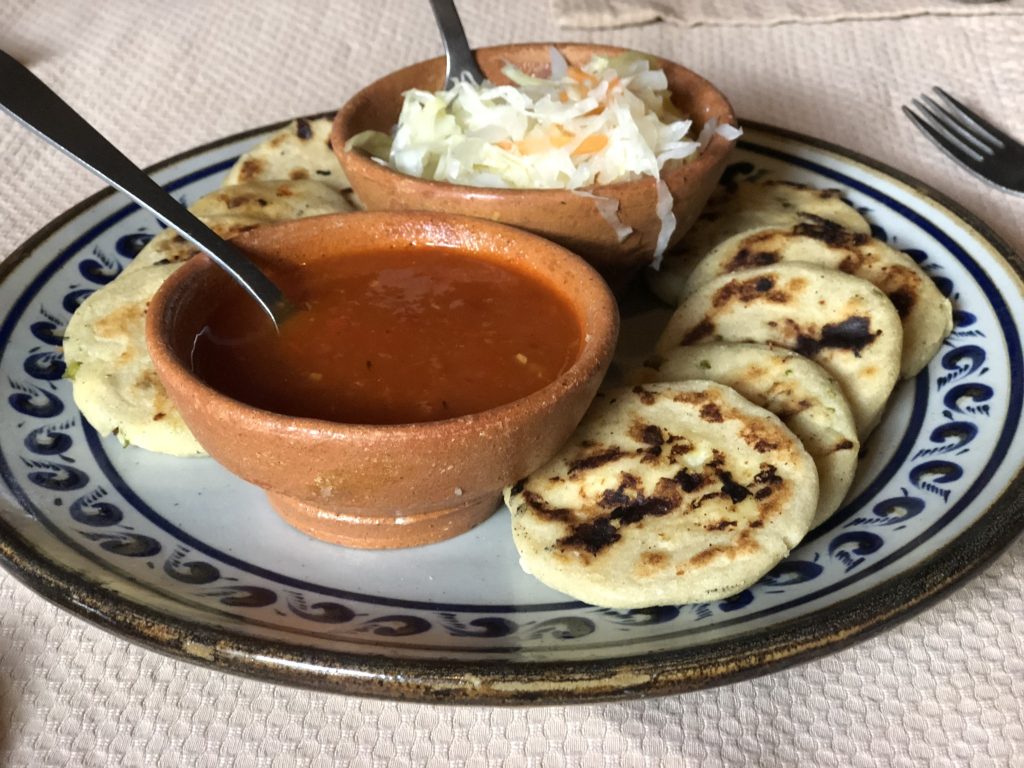
Popuas are also very popular in Honduras, who go as far as disputing the origin of popusas and claiming them as a Honduran dish instead of a dish from El Salvador, although the dish is probably a regional dish and not a dish that belongs to one country in particular. Besides the most common fillings like chicharroon, cheese and beans popusas in Honduras sometimes include fillings like chopped potatoes or finely minced and sauteed jalapeño peppers. This easy recipe for pupusas is based on the traditional pupusas from El Salvador.
El Salvador’s National Dish
In El Salvador, pupusas are a big part of the culture. As you walk through Salvadoran towns, you’ll often see “pupuserías,” which are places where they sell pupusas, and even “pupusódromos,” where a bunch of pupuserías are located right next to each other in one area. Back in 2005, El Salvador officially made the pupusa their national dish.
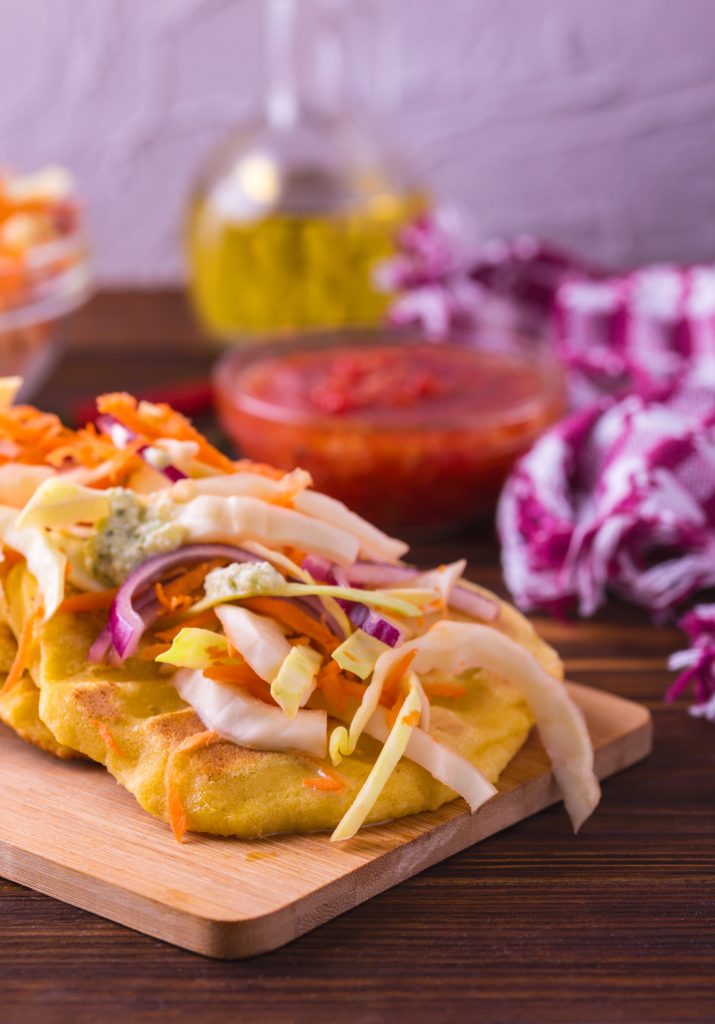
National Popusa Day is celebrate in El Salvador every year since 2005 on the second Sunday in November. On this day families gather, festivals and popusa making competitions are held, and, of course, pupusas are made and enjoyed by everyone.
The pupusa festival in El Salvador is a family event that includes not only the preparation and tasting of pupusas but also cultural activities, live music, and entertainment for adults and children. It is generally held in a natural park on the outskirts of San Salvador. Additionally, some other cities and towns have their own celebrations where activities are carried out. For example, in Olocuilta, the world’s largest pupusa was made a few years ago, and was entered into the Guinness World Records.
Guatemalan Pupusas
Pupusas are a famous dish in both El Salvador and Guatemala, but they have some unique differences between the two countries. In El Salvador, pupusas are the national dish and are celebrated with their own special day. They’re usually filled with cheese, beans, or pork. However, when you look at Guatemalan pupusas, you’ll notice they have their own special touch.
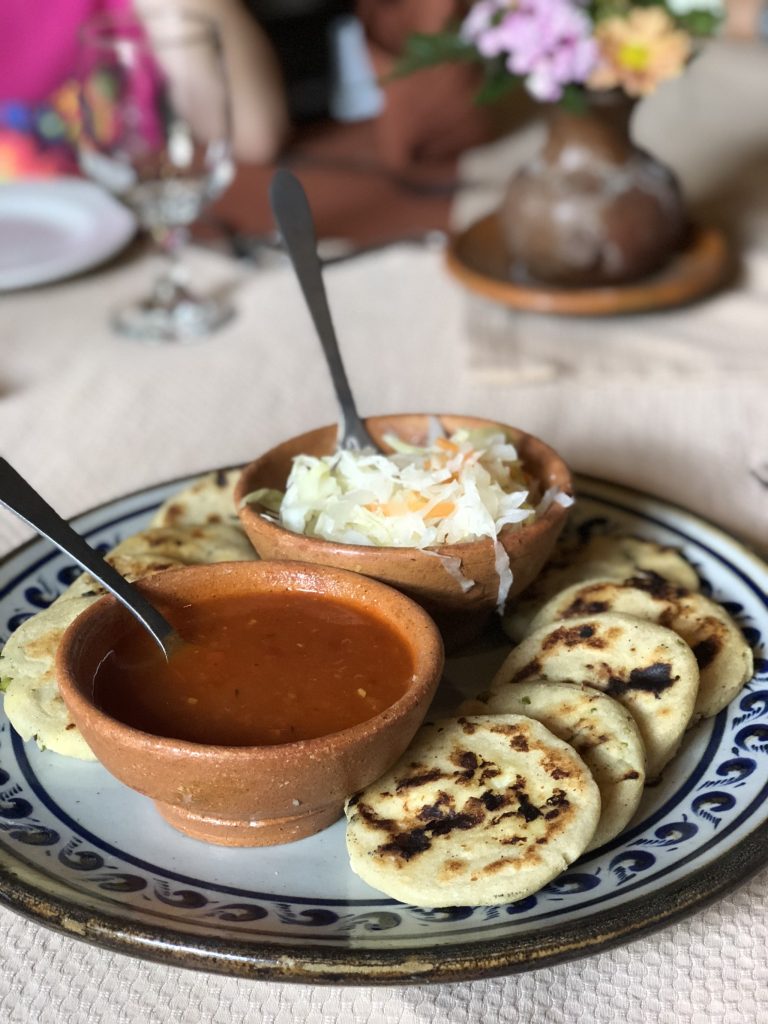
In Guatemala, pupusas might include a wider variety of fillings, like different types of local vegetables or unique cheeses not commonly found in Salvadoran versions. Another difference is that Guatemalan pupusas are often made a bit thinner compared to the thicker Salvadoran style. This makes the Guatemalan pupusas a bit crispier, offering a different texture and eating experience.
Pupusas in Guatemala have become an important part of street food culture. Walking through the streets of Guatemala, you’ll find pupuserias or street vendors selling these delicious stuffed tortillas. They’re a popular choice for a quick and satisfying meal among locals and tourists alike. The ease of eating them on the go makes pupusas a perfect snack or meal for those looking to taste the flavors of Guatemala without stopping for a formal dining experience.
Easy Recipe for Pupusas
What I love the best about this basic recipe for pupusas is that you can add any ingredients that you want too make it your own. Just start with the easy recipe for pupusas and then modify it to your taste.
Ingredients:
For the Pupusas:
- 2 cups masa harina (corn flour)
- 1 1/4 cups warm water
- 1/2 teaspoon salt
- Filling options:
- Grated hard cheese (Salvadoran hard cheese, quesillo cheese, or white cheese like mozzarella)
- Refried beans
- Cooked and seasoned pork (chicharrón)
- Loroco flower buds (if available)
For the Tomato-Based Sauce:
- 4 ripe tomatoes, diced
- 1/2 onion, finely chopped
- 2 cloves garlic, minced
- 1 tablespoon vegetable oil
- 1 teaspoon dried oregano
- Salt and pepper to taste
For the Curtido:
- 3 cups thinly sliced cabbage
- 1 carrot, grated
- 1/2 onion, thinly sliced
- 1/2 cup apple cider vinegar
- 1/4 cup water
- 2 teaspoons dried oregano
- 1 teaspoon salt
- 1 teaspoon sugar
- 2-3 jalapeño peppers, thinly sliced (optional, for heat)

Instructions:
-
Prepare the Pupusa Dough:
-
In a mixing bowl, combine the masa harina and salt.
-
Gradually add warm water and knead until a smooth dough forms. Add more water if necessary.
-
Divide the dough into golf ball-sized portions and cover with a damp cloth to prevent drying out.
-
-
Prepare the Filling:
-
Prepare your desired fillings such as cheese, refried beans, cooked pork, or loroco.
-
If using pork, season it with your choice of spices such as cumin, garlic powder, and salt.
-
-
Make the Tomato-Based Sauce:
-
In a saucepan, heat the vegetable oil over medium heat.
-
Add the diced tomatoes, chopped onion, and minced garlic. Cook until the tomatoes break down and the mixture thickens, about 10-15 minutes.
-
Stir in the dried oregano and season with salt and pepper to taste. Remove from heat and set aside.
-
-
Prepare the Curtido:
-
In a large bowl, combine the sliced cabbage, grated carrot, sliced onion, and jalapeño peppers (if using).
-
In a separate bowl, mix together the apple cider vinegar, water, dried oregano, salt, and sugar until the salt and sugar dissolve.
-
Pour the vinegar mixture over the cabbage mixture and toss until well combined. Cover and refrigerate for at least 1 hour to allow the flavors to meld.
-

-
Assemble and Cook the Pupusas:
-
Take a portion of the dough and flatten it into a disc about 1/4 inch thick.
-
Place a spoonful of your chosen filling in the center of the dough disc.
-
Fold the dough over the filling and pinch the edges to seal, forming a stuffed ball.
-
Gently flatten the ball into a thick pancake, about 1/2 inch thick.
-
Heat a lightly greased skillet or griddle over medium heat.
-
Cook the pupusas for about 3-4 minutes on each side, or until golden brown and cooked through.
-
Repeat with the remaining dough and filling, adding more oil to the skillet as needed.
-
-
Serve:
-
- Serve the pupusas hot off the griddle with the tomato-based sauce and curtido on the side.
- Enjoy these traditional Central American delights as a snack, appetizer, or main course, savoring the flavors and textures of each bite.
Tips for Making the Best Pupusas
Making the best pupusas can be a fun and rewarding cooking adventure. Here are some tips to help you master the art of pupusa making:
- Get the Dough Right: The key to good pupusas starts with the dough. Use masa harina, which is a special corn flour. Mix it with water until it’s soft and doesn’t stick to your hands. If it’s too dry, add a little more water. The dough should be easy to shape but not sticky.
- Choose Your Fillings Wisely: Traditional fillings include cheese, refried beans, and shredded pork, but feel free to get creative. Just remember, the filling shouldn’t be too wet, or it will make the dough hard to seal.
- Don’t Overfill: It might be tempting to stuff your pupusas with a lot of filling, but if you add too much, they might burst open when cooking. A spoonful of filling is usually just right.
- Seal Them Well: After placing the filling on the dough, carefully fold the edges over and seal the pupusa. This might take a little practice, but a well-sealed pupusa will keep the filling inside where it belongs.
- Flatten Gently: Once sealed, gently flatten the pupusa to about a quarter-inch thick. Be gentle to avoid squeezing the filling out or tearing the dough.
- Cook to Perfection: Heat a non-stick pan or griddle over medium heat. Cook each pupusa until it’s golden brown on both sides. They should have a slight crisp on the outside while being soft on the inside.
- Serve Them Right: Pupusas are best served warm, with a side of curtido (a tangy cabbage slaw) and tomato salsa. These sides add a delicious flavor contrast to the warm, comforting taste of the pupusas.
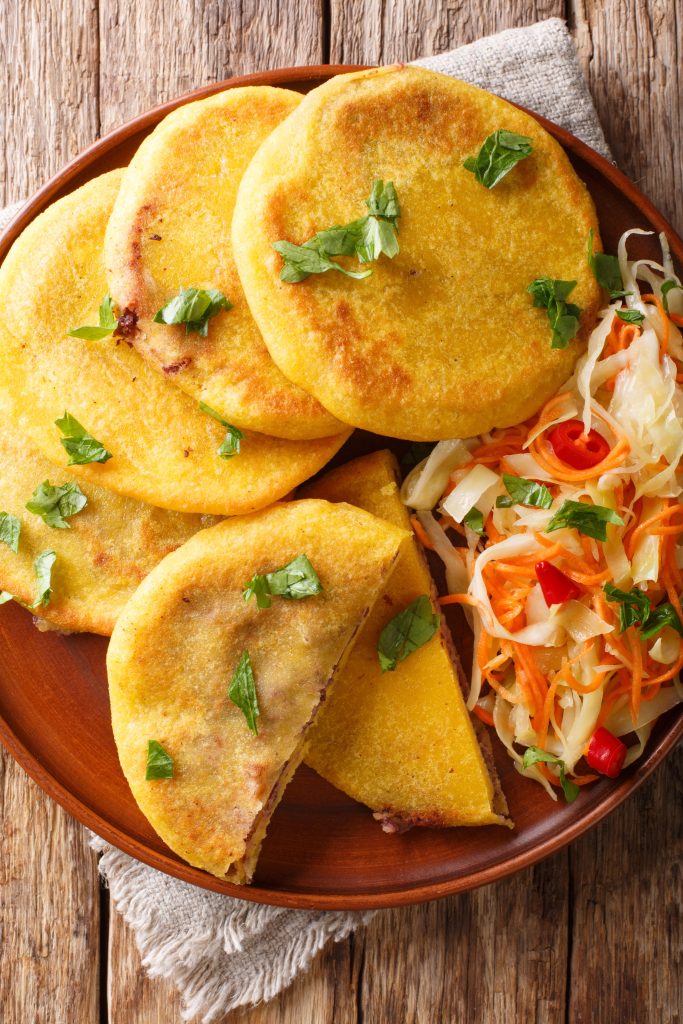
By following this easy recipe for pupusas and these tips you will have delicious pupusas on your table in no time. Remember, making pupusas is as much about the process as it is about the result. Don’t worry if your first few attempts aren’t perfect. With practice, you’ll get the hang of it and develop your own special twist on this traditional dish. Happy cooking!
How to Store Pupusas
Because this is such an easy recipe for pupusas I usually make a double or triple batch which means I always have lots of pupusas left over so that I can store them and reheat them whenever I want. Storing and reheating pupusas so they stay delicious is easy once you know how. If you have leftover pupusas or made extra on purpose, here’s what you must do to keep them tasty for later.
Storing Pupusas in the Fridge:
- Let the pupusas cool down to room temperature after cooking. Putting hot pupusas directly in the fridge can make them soggy because of the steam they release.
- Place them in a single layer on a plate or tray, or you can stack them with a piece of parchment paper between each to prevent sticking.
- Cover the plate or tray with plastic wrap or aluminum foil, or you can put the pupusas in an airtight container.
- Put them in the fridge. They’ll stay good for about 3 to 5 days.
Reheating Pupusas:
To reheat, you can use a skillet over medium heat. No need to add oil, just place the pupusa in the pan and heat each side for a few minutes until they’re warm and slightly crispy again. You can also use a microwave. Just wrap a pupusa in a damp paper towel and microwave it for about 30 seconds to 1 minute. This method helps keep them moist.
Freezing Pupusas:
Yes, you can freeze pupusas, and it’s a great way to save them for later. Follow these steps:
- Cool the cooked pupusas to room temperature.
- Wrap each pupusa individually in plastic wrap tightly to prevent freezer burn.
- Place the wrapped pupusas in a freezer bag or an airtight container and freeze. They can last up to 3 months frozen.
Thawing and Reheating Frozen Pupusas:
When you’re ready to enjoy your frozen pupusas, here’s how to thaw and reheat them:
- Thaw them in the fridge overnight. If you’re in a hurry, you can also thaw them in the microwave using the defrost setting, but be careful not to overdo it or they might become too soft.
- Once thawed, reheat them in a skillet over medium heat until they’re warm on both sides. You can also reheat them in the microwave for a quick option, just remember to use a damp paper towel to keep them moist.
Following these steps will help you enjoy your pupusas just like they were freshly made, whether you’re eating them the next day or pulling them from the freezer for a quick and tasty meal.
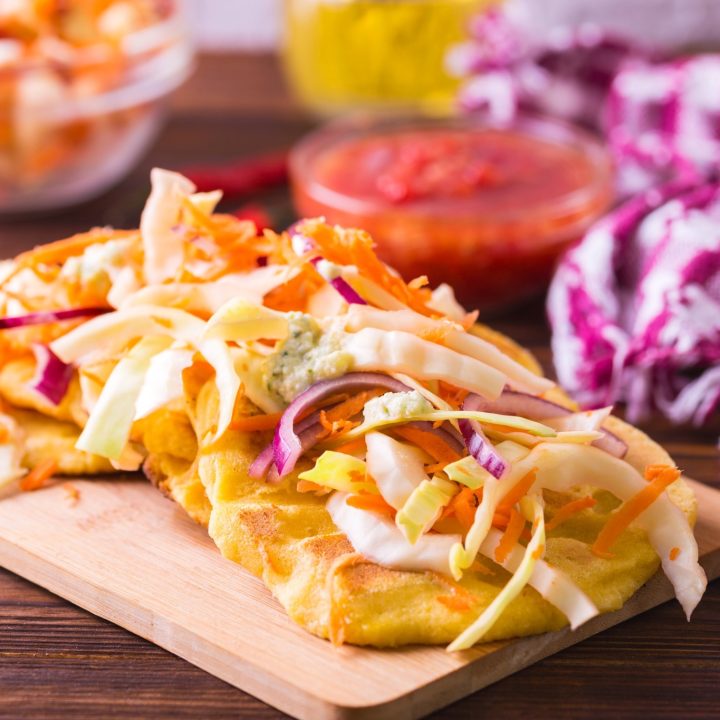
Easy Recipe for Pupusas: How to Make the Best Pupusas
Ingredients
- FOR THE PUPUSAS:
- 2 cups masa harina (corn flour)
- 1 1/4 cups warm water
- 1/2 teaspoon salt
- FILLING OPTIONS:
- Grated hard cheese (Salvadoran hard cheese, quesillo cheese, or white cheese like mozzarella)
- Refried beans
- Cooked and seasoned pork (chicharrón)
- Loroco flower buds (if available)
- FOR THE TOMATO-BASED SAUCE:
- 4 ripe tomatoes, diced
- 1/2 onion, finely chopped
- 2 cloves garlic, minced
- 1 tablespoon vegetable oil
- 1 teaspoon dried oregano
- Salt and pepper to taste
- FOR THE CURTIDO:
- 3 cups thinly sliced cabbage
- 1 carrot, grated
- 1/2 onion, thinly sliced
- 1/2 cup apple cider vinegar
- 1/4 cup water
- 2 teaspoons dried oregano
- 1 teaspoon salt
- 1 teaspoon sugar
- 2-3 jalapeño peppers, thinly sliced (optional, for heat)
Instructions
Prepare the Pupusa Dough:
- In a mixing bowl, combine the masa harina and salt.
Gradually add warm water and knead until a smooth dough forms. Add more water if necessary. - Divide the dough into golf ball-sized portions and cover with a damp cloth to prevent drying out.
Prepare the Filling:
- Prepare your desired fillings such as cheese, refried beans, cooked pork, or loroco.
- If using pork, season it with your choice of spices such as cumin, garlic powder, and salt.
Make the Tomato-Based Sauce:
- In a saucepan, heat the vegetable oil over medium heat.
- Add the diced tomatoes, chopped onion, and minced garlic. Cook until the tomatoes break down and the mixture thickens, about 10-15 minutes.
- Stir in the dried oregano and season with salt and pepper to taste. Remove from heat and set aside.
Prepare the Curtido:
- In a large bowl, combine the sliced cabbage, grated carrot, sliced onion, and jalapeño peppers (if using).
- In a separate bowl, mix together the apple cider vinegar, water, dried oregano, salt, and sugar until the salt and sugar dissolve.
- Pour the vinegar mixture over the cabbage mixture and toss until well combined. Cover and refrigerate for at least 1 hour to allow the flavors to meld.
Assemble and Cook the Pupusas:
- Take a portion of the dough and flatten it into a disc about 1/4 inch thick.
- Place a spoonful of your chosen filling in the center of the dough disc.
- Fold the dough over the filling and pinch the edges to seal, forming a stuffed ball.
- Gently flatten the ball into a thick pancake, about 1/2 inch thick.
- Heat a lightly greased skillet or griddle over medium heat.
- Cook the pupusas for about 3-4 minutes on each side, or until golden brown and cooked through.
- Repeat with the remaining dough and filling, adding more oil to the skillet as needed.
Serve:
- Serve the pupusas hot off the griddle with the tomato-based sauce and curtido on the side.
- Enjoy these traditional Central American delights as a snack, appetizer, or main course, savoring the flavors and textures of each bite.
Notes
Nutrition information is based on cheese pupusas using 2 cupos of grated mozzarella cheese or similar. Nutrition information will change if using other ingredients or a different kind of cheese.
Nutrition Information:
Yield: 8 Serving Size: 1Amount Per Serving: Calories: 246Total Fat: 9gSaturated Fat: 4gTrans Fat: 0gUnsaturated Fat: 4gCholesterol: 22mgSodium: 625mgCarbohydrates: 32gFiber: 5gSugar: 6gProtein: 10g


